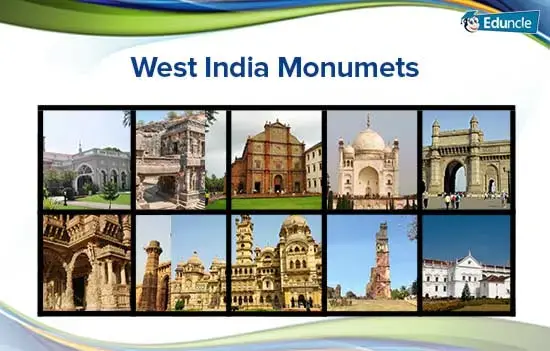
India is a nation which is well known for its wide range of Historical Monuments. The country is a beautiful amalgamation of diverse culture, religions, traditions and customs.
People call India as ‘Sone Ki Chidiya’ as India is a land of beautiful ancient architecture which attracts people’s attention and makes them anxious to know more about them in detail.
The Monuments of India are the result of long period of invasion. Historical Places of India represents the great achievement in art and architecture. These monuments were built by Indian Kings as a symbol of their glory in wars or to represent the beautiful cultural heritage of India.
Historical Monuments of India is a major topic from Static GK and questions are asked about the locations or the facts related these monuments in the Government Jobs Exams like SSC Exam, Railway Exam, UPSC. Every Historical Place in India has a fascinating history associated with that makes it even more exciting to visit.
So, here in this article, we have gathered all the information regarding the Famous Monuments of India and the history behind the formation of these places. Let’s explore all these in detail and fill up your knowledge bucket.
Famous Historical Monuments of India-Reflecting Indian Cultural Heritage!
The royal past and the colonial rule in the different regions of the Country have left the country with a wide range of Ancient Monuments of India which are of great significance.
The region-wise knowledge of these monuments will help you to explore the history of the nation with better understanding. So, let’s have a look at these monuments.
This article includes Historical Monuments of India from the below mentioned 5 regions.
North Indian Monuments / Historical Places in India

The Northern part of India is rich in cultural heritage which attracts tourists through the beauty of its designed monuments. North Indian cities like Agra, Jaipur, Delhi (known as a golden trio of North India) offers a large tourist attraction. Here is the list of popular North Indian monuments to visit.
Taj Mahal, Agra, Uttar Pradesh
Taj Mahal is famous as 7th Wonder of the World. It was built by Mughal emperor Shahjahan in the memory of his beloved wife, Mumtaz Mahal (Arjumand Banu Begum). The Indian architect of Persian descent, Ustad Ahmed Lahori has been named for constructing the building. The construction started in 1630 and finally completed in the year It is made of a white marble initially known as Pietra Dura. It is also a UNESCO’s World Heritage Site.
Agra Fort, Agra, Uttar Pradesh
Agra Fort was built by the Great Mughal Emperor Akbar in 1565-75 AD on the banks of the Yamuna river. It is enclosed with 70 feet high wall of red sandstone. It contains Jahangir Mahal, Khass Mahal, Diwan-i-Khas, Diwan-i-Am, Machchhi Bhawan and Moti Masjid. This fort is said to be the symbol of power, strength and resilience. It encompasses the imposing Mughal style of art and architecture. It is also a UNESCO’s World Heritage Site.
Qutub Minar, Delhi
Qutub Minar was built by Qutub-Ud-Din-Aibak in early 13th century with red sandstone. It is recognized as the tallest brick minaret in India. The unique feature of this pillar is- its high corrosion resistant nature due to which there is no sign of rust in this pillar till now. It has 4 houses- Quwwatu'l-Islam Mosque, The Iron Pillar, Alai Minar & Alai Darwaza. It is also a UNESCO’s World Heritage Site.
Fatehpur Sikri, Agra, Uttar Pradesh
Fatehpur Sikri was built by the great Mughal emperor Akbar in 1571-1585 and was later established as the capital of Mughal Empire. It is made of red sandstone. It consists of beautiful palaces, halls, and mosques. Some of the major Historical Places in Fatehpur Sikri are: Buland Darwaza, Diwan-i-Khas, Panch Mahal, Tomb of Salim Chisti. In addition to these, there are other important Historical Monuments in Fatehpur Sikri like the Palace of Jodha Bai, Birbal Bhawan, Diwan-i-Aam and Karawan Serai. It is also a UNESCO’s World Heritage Site in India.
Humayun’s Tomb, Delhi
Humayun's Tomb was designed by Misak Mirza Ghiyas and was built by Humayun’s wife Hamida Banu Begum (Haji Begum) in 1569 AD. It is an excellent example of Persian architecture. It is made of red sandstone. The tomb is surrounded by a beautiful Mughal garden. It is included in the UNESCO’s World Heritage Site.
Golden Temple, Amritsar
Sri Harmandir Sahib also known as the Golden Temple is the holiest Gurudwara of Sikhism. It was founded by the fourth Sikh Guru, Guru Ram Das in 1577. Inside the temple, the Sikh holy books, Adi Granth and Guru Granth have been placed by Guru Arjan. It is gilded with 750 kg of pure gold, hence named Golden temple. The four doors symbolize the openness of the Sikhs towards all people and religions.
Hawa Mahal, Jaipur, Rajasthan
Hawa Mahal was built by Maharaja Sawai Pratap Singh of Kachhwaha Rajput Dynasty in 1799. It is a five-storey building which is made of pink and red sandstone. It facilitates women of the royal family to see the outside street festivals and busy city life without having to be seen by the others. There are about 953 jharokhas or windows, some of which are made of wood. It has a height of 15m and its shape resembles the crown of Lord Krishna. This historical Monument of India is often referred to as the Palace of Winds.
India Gate, New Delhi
India Gate is located in Rajpath, New Delhi. It is a war memorial which was built to honour 82000 soldiers of the Indian Army who sacrificed their lives during the World War-I between 1914-1921. It was built with Yellow and red sandstone and granite by an architect, Sir Edwin Lutyens. It is 42m in height and 9.1m in width and has a diameter of 625m with an area of 306,000 metres. Amar Jawan Jyoti is situated below the arch of India Gate, which is dedicated to the soldiers who sacrificed their lives during Indo-Pakistan war of 1971.
Red Fort, Delhi
Red Fort was constructed by fifth Mughal Emperor Shah Jahan in 1639 when he shifted his capital from Agra to Delhi. It took 10 years (1638-1648) to complete. The Red fort was originally named Qila-e-Mubarak, as it was the residence of the royal family. The most interesting fact about this Historical Monument of India is that the red fort was originally white. As per the Archaeological Survey of India, parts of the building were made of limestone. After it was painted red, the British started to call it Red Fort. This octagonal fort is also the site where the President gives his speech on Independence Day.
Amer Fort, Jaipur, Rajasthan
Amer Fort was built by Raja Man Singh I and it is the finest example of Rajput architecture in Rajasthan. It is located on Cheel ka Teela on Aravalli Hills. Amer Fort and Jaigarh Fort are connected through a subterranean passage and it is believed that this passage was used at the time of war or enemy attacks. The fort was built in red sandstone and marble and has the influence of both Hindu and Muslim architecture. It consists of Diwan-i-Aam, Diwan-i-Khas, Sheesh Mahal, Jai Mandir and Sukh Niwas.
South Indian Monuments / Historical Places in India

South India is mostly known for its temples than any other historical monuments. The famous Meenakshi Temple, Kanchipuram Temple, Mahabalipuram are the favorite tourist destinations of South India. Let’s have a look at some of the list of famous Historical Monuments / Places of South India in detail.
Charminar, Hyderabad, Telangana
Charminar was built by Muhammad Quli Qutub Shah in 1591 in the beautiful city of Nizams. It is often called as "The Arc de Triomphe of the East". It is located on the banks of Musi river. Charminar is close to Lad Bazar and Macca Masjid. It is made up of Granite and Lime Mortar. It has 4 minarets of height 56m and hence named Charminar. It has a square structure with each side 20m long. It has a winding of 149 steps that leads to the top of the building.
Meenakshi Temple, Madurai, Tamil Nadu
Meenakshi Temple is a historic Hindu temple located on the banks of the Vaigai river. The temple is dedicated to Sundareswarar (Lord Shiva) and Meenakshi (Goddess Parvati). It was built between 1623-1655. It has 14 gopurams (gateway towers) ranging from 45-50m in height. The temple was looted by the Muslim raider Malik Kafur. The restoration was undertaken by the Nayak ruler Vishwanatha Nayakar in the 16th
Hampi, Karnataka
Hampi was built by Harihara and Bukkaraya on the banks of the Tungabhadra river in the Northern parts of Karnataka. It was traditionally known as Pampakshetra of Kishkindha. Hampi was the capital of Vijayanagar It is UNESCO’s World Heritage Site in India due to rocky and chariot structures. It consists of more than 500 monuments which are a collection of beautiful temples, palaces, aquatic structures, ancient market streets, royal pavilions, bastions, royal platforms and treasury buildings.
Gol Gumbaz, Bijapur, Karnataka
Gol Gumbaz is located in the Bijapur district of Southern India state of Karnataka. Bijapur is famous for its beautiful monuments built in Islamic architecture during the reign of Adil Shahi Dynasty. The tomb is known as the Taj Mahal of South India. It was completed in 1656 by an architect Yaqut of Dabul. It is a mausoleum of Mohammad Adil Shah and finds its name from Gol Gummata which means circular dome. It has been built with dark gray basalt stone. The central dome has a diameter of 44 m, which makes it the second largest dome in the world after the dome of Peter’s Basilica in Vatican, which is unsupported by any pillars.
Mahabalipuram, Tamil Nadu
Mahabalipuram also known as Mamallapuram is located in the Kanchipuram district, which is close to Chennai in the state of Tamil Nadu. It is one of the oldest cities in India and known for its various stone carved ancient monuments and temples of India. The place was ruled by the Pallava kings, Mahendravarman-I and Narsimhavarman-I and is attributed for the designing of the monuments in 7th century AD. Mahabalipuram has a group of sculptures carved out of the rock. They are: Rathas (temples in the form of chariots), Mandaps, Descent of the Ganges, the caves of Govardhanadhari and Mahishasuramardini, Shore Temple and the Arjun’s Penance. It is also UNESCO’s World Heritage Site.
Tirupati Balaji, Andhra Pradesh
Tirupati Balaji is famous as the World’s richest temple situated in the Tirumala town in the Chittoor district of Andhra Pradesh. The temple is dedicated to the Lord Sri Venkateswara, who is believed to have appeared here to save mankind from the troubles of Kali Yug. The temple is constructed in Dravidian architecture and its construction was started from 300 AD. The Pallavas of Kancheepuram, the Cholas of Thanjavur, the Pandyas of Madurai were devotees of the Lord Venkateswara. It was during the time of Sri Krishnadevraya, the contributions to the temple increased.
Mysore Palace, Karnataka
Mysore Palace also known as the Amba Vilas Palace is a royal palace of the rulers of the Mysore city, Yaduraya Wodeyar and Krishnaraja Wodeyar IV. It was built during the 14th century and has an Indo- Saracenic architectural style. The palace has two durbar halls and an array of courtyards, gardens and buildings. It is incorporated with the Hindu, Muslim, Rajput and Gothic style of architecture. It was rebuilt after the former wooden palace was destroyed by the fire in the year 1897 during a royal wedding. The three-storied building of the palace stretches across a length of 245 feet and 156 feet in breadth. It is a fine gray granite building with deep pink marbles dome and has three entrance-East, West, South Gate.
Chola Temples, Tamil Nadu
Chola temples were built by the kings of the Chola Empire during the 11th-12th These temples include: the Brihadisvara Temple at Thanjavur, the Brihadisvara Temple at Gangaikondacholisvaram and the Airavatesvara Temple at Darasuram. The Brihadisvara Temple at Thanjavur was declared as UNESCO’s World Heritage Site of India in 1987. These Chola temples represent the Dravidian style of architecture. The site is also known as the Great Living of Chola Temples.
Vivekananda Rock Memorial, Kanyakumari
Vivekananda Rock Memorial was built in the year 1970. It is located 500 m east of mainland of Vavathurai, Kanyakumari, India. It was believed that the Swami Vivekananda came to Kanyakumari in the year 1892 before his departure to Chicago to participate in the World Religious Conference in 1893. He sat on meditation on this rock for two days and became powerful spiritual leader and philosopher. The memorial has a statue of Swami Vivekananda which was made by the sculptor Shri N L Sonavadekar of Sir J. J. School of Arts, Bombay. The Memorial has a mixture of conventional and modern Indian architectural style. It has two main structures:
1. Vivekananda Mandapam
2. Sripada Mandapam
Padmanabhapuram Palace, Kanyakumari, Tamil Nadu
The Padmanabhapuram Palace is located in the Padmanabhapuram district in Kanyakumari, Tamil Nadu and maintained by the Government of Kerala. It is a magnificent wooden palace built by the Travancore rulers in the 16th century. It is situated 50km away from the Thiruvananthapuram The Palace consists of several structures.
1. Mantrashala: King’s Council Chamber
2. Thai Kottaram: The Queen’s Mother Palace
3. Natakshala: Performance Hall
4. A four-storeyed mansion at the centre of the complex.
5.Thekee Kottaram: Southern Palace
East Indian Monuments / Historical Places in India

East India represents the diversified image of India as it has been the home of people with different religions and culture. The architecture of Historical Monuments of India in eastern parts of India can be seen especially in the states of Bihar, Orissa, Jharkhand, West Bengal with invasions of Mughals and British.
Mahabodhi Temple, Bodhgaya, Bihar
Mahabodhi temple was built in the 3rd century. It is a famous UNESCO’s World Heritage Site where Lord Buddha attains his enlightenment while meditating under a fig tree. Emperor Asoka visited Bodh Gaya around 260 B.C. and constructed a small temple near the Bodhi tree. It is the first Buddhist temple to be built entirely from bricks. Apart from the grand Statue of Lord Buddha it also consists of several other places like Buddha tree, lotus pond, and several ancient stupas. The tallest tower of the Mahabodhi temple is 180 feet high while its main Vault has been coated with 290 kg of gold plates by the Government of Thailand.
Konark Sun Temple, Orissa
Konark is a combination of two words-Kona means corner and Ark means Sun. So combinedly it becomes Sun of the Corner. It was built by Narsimhavarman -I of Eastern Ganga Dynasty in 1255. The temple is dedicated to the Sun god Surya. It follows the traditional style of Kalinga architecture. It is also known as The Black Pagoda because of its dark color. The temple has seven spirited horses on 12 pairs of stone carved wheels which are the inspiration for modern time watches. It is also UNESCO’s World Heritage Site in India. The temple has three images of the Sun God. Each image is positioned in a way as to catch the rays of the sun each in the morning, at noon and during sunset.
Nalanda University, Bihar
Nalanda University was one of the earliest university founded by the Gupta dynasty in the fifth century. The term Nalanda was derived from three Sanskrit words: Na+ Alam+ Daa which means No stopping of the gift of Knowledge. The library at Nalanda University constituted of three main buildings, which rose to about nine stories. The University was destroyed by the Muslim ruler named Bakhtiyar Khilji in 1193. Eight hundred years after the destruction of Nalanda, former President of India Dr. A.P.J. Abdul Kalam, while addressing the Bihar State Legislative Assembly, in March 2006 mooted the idea of reviving the university.
Udaygiri and Khandagiri Caves, Orissa
Udaygiri and Khandagiri are the caves of archaeological, religious, historical importance and is one of the Important Historical Places in India, situated in Orissa. The hills house a number of caves, most of which have been carved out by Jain monks and artisans from the times of King Kharavela (of the Mahameghavahana dynasty). The Udaygiri which means Sunrise Hills consists of 15 caves and Khandagiri consists of 18 caves. The Rani Gumpha or the Queen’s Cave is the largest cave in Udaygiri caves. The Ganesa Gumpha at Udaygiri Caves shows a Jain Tirthankara at worship and contains sculptures of elephants. The Ananta Gumpha is a very interesting cave in Khandagiri Caves which consists of ancient Jain motifs such as Swastikas and serpents. The Navamuni Gumpha of Khandagiri Caves carries sculptures depicting 9 Jain Tirthankaras or seer-sages.
Lingaraja Temple, Orissa
The Lingaraja temple is one of the famous temples of Orissa. It represents the style of Kalinga Architecture. The temple is dedicated to Lord Shiva, who was also known as, Lingaraja or Harihara. It was built by the King Jajati Keshari of Somavamsi dynasty 617-657 AD, when he shifted his capital from Jaipur to Bhubaneshwar. The temple is surrounded by 150 temples belonging to different Gods of Hindu religion. It has a height of 54 m and consists of various pillars and halls which add to its beauty.
Victoria Memorial, Kolkata, West Bengal
Victoria Memorial was conceptualized by Lord Curzon, the Viceroy of India. It was built between 1906 to 1921 and is situated on the banks of the Hooghly river. It was built to commemorate Queen Victoria. It is made up of white marble and is the most popular tourist destination of East India. It was designed in Indo-Saracenic architectural style. It consists of a remarkable collection of paintings, artifacts, weapons, books, statues.
Jagannath temple, Puri, Orissa
Jagannath Puri was built in the year 1078. The conduction of the temple was initiated by the King Chodagangadeva and was completed by his grandson Anangbhimadeva. It is the important pilgrimage destination of India, being one of the Char Dhams visited by millions of devotees every year. The main structure of the temple is 65m high and is built on elevated ground. The temple is famous for its annual Rath Yatras. There is a wheel on the top of the temple which is made up of the eight alloys (asth-dhatu) and called Neel Chakra. The Gods Jagannath, Balabhadra, and the Goddess Subhadra are worshiped at the temple.
Howrah Bridge, Kolkata, West Bengal
Howrah Bridge is the World’s fourth busiest cantilever bridge, situated on the Hooghly River and connects the two cities of Kolkata and Howrah. The most interesting fact about the bridge is that it does not have nuts and bolts and was built by riveting the whole structure. The bridge also named Rabindra Nath Setu after Rabindra Nath Tagore, who was the first Indian and Asian Nobel Laureate. It took 7 years to complete and it has a length of 1528 feet and width of 62 feet. The unique architectural style of the bridge includes 18, 500 tons of high tension steel.
Shaheed Minar, Kolkata, West Bengal
Shaheed Minar, formerly known as Ochtorlony Monument was built in the year 1848 to honour Sir David Ochtorlony who served in the Nepal War (1814-1816). Later it was named Shaheed Minar to honour the sacrifices of Indian freedom fighters. It was designed by an architect P. Parker. the monument is 48m (158 feet) high and is a blend of European, Syrian and Turkish style of architecture. Mark Twain famously termed the Shahid Minar as “cloud-kissing monument.”
Indian National Army Memorial, Manipur
Indian National Army Memorial is a war memorial at Moirang, India which is dedicated to the soldiers of Indian National Army. It was first founded in 1942 by Captain Mohan Singh. The Complex has a life-size statue of Netaji and a Memorial Museum. The Museum displays various letters, photographs, badges of ranks and other memorable things reminding the noble sacrifices made by the INA. The total cost of constructing the INA Complex is Rs. 6.23 crores.
West Indian Monuments / Historical Places in India

World heritage monuments in West India distinguish themselves from others for their outstanding architecture and intrinsic sculptures. Western India mainly acquainted with the historical monuments that attract tourists, beautifully designed churches of Goa and architecture of Mumbai. Here are some famous West Indian Historical Monuments.
Ajanta and Ellora Caves, Aurangabad, Maharashtra
Ajanta and Ellora Caves are one of the oldest UNESCO’s World Heritage Site. It is known for its beautiful carvings and paintings dating to the beginning of the era of classical Indian Art. It was built during 2nd century BC. It is a horseshoe shaped rock cave which was discovered by Jon Smith while hunting a tiger. These caves are mostly related to the Buddhism, Jainism and Hinduism arts. There are total of 34 caves out of which, 12 caves belong to Buddhism, 17 caves to Hinduism and 5 caves to Jainism. The construction of these caves was carried out in 2 phases. The first phase of construction was carried out during the rule of Satavahana dynasty and the second phase was carried out during the rule of Emperor Harishena of Vakataka dynasty.
Gateway of India, Mumbai, Maharashtra
The Gateway of India is a monument built during the 20th century. It is famous for the Indo-Saracenic style of architecture. The main objective behind the construction of the Gateway of India was to commemorate the visit of King George V and Queen Mary to Bombay (Mumbai). It was designed by an architect, George Wittet. The central dome has a diameter of 48 feet and it has a height of 83 feet. The monument is made up of yellow basalt and is known as the Taj Mahal of Mumbai. Later on, the statues of Chhatrapati Shivaji and Swami Vivekananda were also installed at the Gateway.
Lakshmi Vilas Palace, Vadodara, Gujarat
Laxmi Vilas Palace was built by Maharaja Sayajirao Gaekwad III in 1890. It has been built in the Indian- Saracenic style of architecture. This historical place has a remarkable collection of armours and sculptures in bronze, marble and terracotta. The palace was designed by an architect Major Charles Mant. The palace ground consists of the golf course, Sayajirao’s Museum and paintings made by Raja Ravi Verma.
Se Cathedral, Goa
Se Cathedral is the largest church located in old Goa on the banks of Mandovi river. The church is dedicated to the Catherine of Alexandria. It was built to commemorate the victory of Portuguese under Afonso de Albuquerque over Muslim army. It has a Portuguese- Manueline architecture style. It has a length of length if 250 feet and breadth of 181 feet. It was designed by Julio Simao and Ambrosio Argueiro, the Stalwart engineers. Originally, there were three towers, but one was destroyed due to lightening. The southern tower has a famous bell, also known as Golden Bell. The church is also declared as the UNESCO World Heritage Site.
Jhulta Minar, Ahmedabad, Gujarat
Jhulta Minar, also known as Sidi Bashir Mosque or Shaking Minaret because of its unique construction. The mosque was completed in 1452 but was destroyed in 1753 during the war between Marathas and Khan. Since then only the minarets and arch gateways remain. It is believed that these minarets were built to reduce the damages of the earthquake.
Hutheesing Jain Temple, Ahmedabad, Gujarat
The temple was built in the year 1848 by a merchant Seth Hutheesing as a dedication to the 15th Jain Tirthankara, Shri Dharmanath. It has been built using white marbles. Mahavir Stambha, which is 78ft in height, is a recent addition to this beautiful temple and has been inspired by the well-known tower at Chittor in Rajasthan. The tower is situated at the front entrance of the temple. The temple was designed by the architect Premchand Salat.
Basilica of Bom Jesus, Goa
The Basilica holds the remains of St. Francis Xavier. It is the most famous church located in old Goa and was built in the 17th century by the Portuguese. It is UNESCO World Heritage Site and is the most important Christian pilgrimage destination all over the world. The design of the church was inspired by the church St. Paul. It was designed by the sculptor Giovanni Battista Foggini.
Bibi Ka Maqbara, Aurangabad, Maharashtra
Bibi ka Maqbara is a mausoleum of Rabia-ul-Daurani (Dilras Banu Begum), the wife of the Mughal Emperor Aurangzeb. The mausoleum was constructed by the Prince Azam Shah, the son of Aurangzeb, in the memory of his mother between 1651 to 1661. It resembles with the design of the famous Taj Mahal, it is often referred as the Taj of the Deccan. This Indian Monument was designed and erected by Atta Ullah, an architect and Hanspat Rai, an engineer respectively.
Aga Khan Palace, Pune, Maharashtra
The Aga Khan Palace was built by Sultan Mohammad Shah, Aga Khan III in the years 1892. It was an act of charity by Sultan who wanted to help the poor in the neighboring areas. Aga Khan Palace acts as a national monument during Indian freedom struggle. Mahatma Gandhi, Kasturba Gandhi, Mahadev Desai and Sarojini Naidu were imprisoned in the palace during Indian Freedom Movement. It is also a place where Kasturba Gandhi and Mahadev Desai died. The palace is known for its architectural excellence.
Ruins of St. Augustine's Tower, Goa
The church is located on the Holly Hill (Monte Santo) at Old Goa near Nunnery. It was created in the year 1602 AD by twelve Augustinian monks. It is a 46m high tower and is one of the four towers of St. Augustine Church. The church is dedicated to Our Lady of Grace and was built from laterite.
Central Indian Monuments / Historical Places in India

Central India consists of various ancient structures like Gwalior Fort, Amarkantak which are must to visit places and visited by many tourists worldwide. Here is the list of some famous Ancient monuments of India to visit. Let’s know them in detail.
Khajuraho Temples, Chattarpur, Madhya Pradesh
Khajuraho Temples is a group of Hindu and Jain temples that was built in between 950 to 1050 AD by Chandella rulers. Historical records show that there were 85 temples listed in Khajuraho out of which only 25 temples are found now. Khajuraho is also described with the name of Jejakbhukti. The Khajuraho temples are known for the incredible designs and depicted on the temple walls. It is also UNESCO’s World Heritage Site.
Gwalior Fort, Gwalior, Madhya Pradesh
Gwalior Fort was built in the 8th century by Man Singh Tomar for his Queen Mrignayani. It consists of two main palaces: Gujari Mahal, Man Mandir. Gwalior Fort spreads out in an area of 3 square kilometers and surrounded by concrete walls of sandstone. The fort is built on a rocky hill Gopachal. The Teli-Ka-Mandir is the most famous of all the temple of the Gwalior Fort. The fort also has a special place in the field of human civilization as it was the place which has the first ever recorded use of ‘zero’.
Shiv Temple in Chandkhuri, Raipur, Chhattisgarh
The Temple was built in 10th-11th century AD and contains figures of river goddesses Ganga & Yamuna. There is a depiction of wrestling between Bali and Sugriva and of weeping Tara (Bali’s wife) seeing the dead body of her husband. The Temple does not have any mandap.
Jai Vilas Palace, Gwalior, Madhya Pradesh
The Jai Vilas Palace was established by the Maharaja of Gwalior, Jayajirao Scindia in 1874. The palace was designed and built by Michael Filose and is the finest example of European architecture. It spreads over an area of 12,40,771 square feet. The most popular attraction of the palace is the Durbar Hall, which is beautifully decorated with gold furnishings. Other attractions of the palace include reading rooms, drawing rooms, JSM hall, and breakfast room.
Sanchi Stupa, Madhya Pradesh
The Sanchi Stupa was built by the Mauryan Emperor Ashoka in the 3rd century. It has a remarkable collection of Buddhist art and architecture. It consists of four gateways facing towards all four directions. The Sanchi Stupa is a huge semi-circular, dome-shaped chamber in which the relics of Lord Buddha are kept. It is also listed as the UNSECO’s World Heritage Site in India.
Bastar Palace, Chhattisgarh
This Bastar Palace was constructed by the kings of the Bastar State and has the historical importance. According to the historical records, this palace was being built during the prehistoric times after the shifting of the capital at Barsur to Jagdalpur by the rulers. The main point of attraction for the visitors in this palace is the superb figurines and drawings that can be seen on the ceiling and the walls of this palace. Another major point of attraction is the glittering of the fort in sunlight which is another remarkable addition to its beauty.
Monuments in Shivpuri, Madhya Pradesh
Shivpuri which means the ‘City of Lord Shiva’. It is a small town and a sacred place in Madhya Pradesh. The dense forests of Shivpuri were earlier used for hunting by the Mughal emperors. There are various cultural sites to visit here. They are: Tatya Tope Memorial, Madhav Vilas Palace, George Castle, Madhav National Park, Chattri.
Amarkantak, Madhya Pradesh
Amarkantak is known as the Teerthraj, The King of Pilgrimage. It is a region which is rich in natural heritage. It is a meeting point of Vindhya and Satpura ranges. The Narmada river, the Sone river and the Johila River emerge from this place. Amarkantak hills have an altitude of 1065m. There are 24 temples around Amarkantak dedicated to Goddess Narmada and Devi Sati. The Trimukhi temple which is dedicated to Lord Shiva is the oldest temple in Amarkantak.
Rajwada Palace, Madhya Pradesh
Rajwada Palace also known as Holkar Palace is situated in the Indore city of Madhya Pradesh and is the major tourist attraction because of its architectural design. The palace was built in 1747 AD using Mughal, Maratha and French style of architecture. It was constructed by Malhar Rao Holkar. The palace is partly built of stone and the remaining wood.
Jain Rock Sculptors, Madhya Pradesh
Jain Rock Sculptors are situated along the path leading to the Gwalior fort from the south side near the Urwahi Gate. The sculptors are carved out of rock faces that represent the Jain Tirthankaras. These large and small, standing and seating images of Jain Tirthankaras had been cut from the hill during the 15th century when the fort was under the control of Tomar Kings. The 57 feet figure of Parshvanath seated on a lotus and 30 feet figure of seated Neminatha with a symbol of shell on a pedestal are the major attractions here. These sculptors were disfigured by the armies of Mughal emperor Babur in 1527, but some of them were later restored.
Suggested Reads:
Indian National Symbols- National Flag, Emblem & Anthem
List of Nobel Prize Winners & Laureates from India
15 Amazing Facts You Might be Unaware About the Indian Constitution
40 famous National Organizations Asked in Govt. Job Exams
Above we have covered the famous List of Historical Monuments and Places of India which are of great importance. These monuments have a splendid architectural style which makes these places to be uniquely stand out in the world.
You must visit these places at least once in a lifetime as the beauty and the amazing and interesting history behind their formation will definitely mesmerize you once you visit these places.
Your suggestions are welcomed if we have missed something. Please share your views and suggestions in the comment box provided below.
Also share this information with your friends, if you find the information useful, as sharing is caring so do share it.
You can also connect with us via our social media channels.
Thankyou!
Happy Learning


















